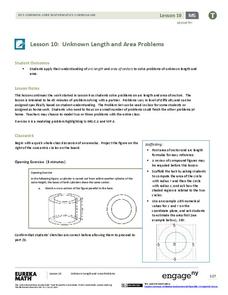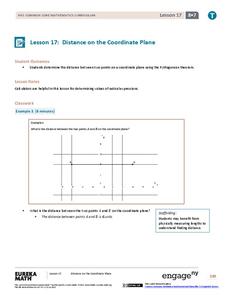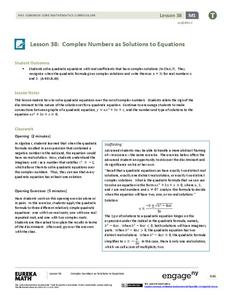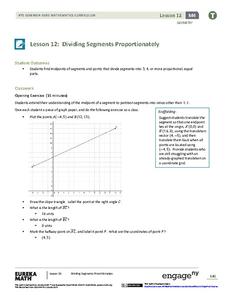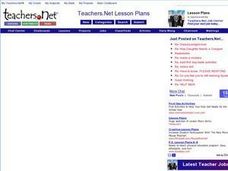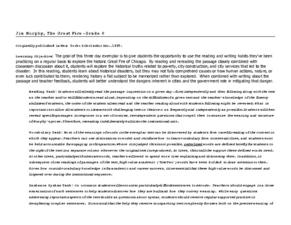EngageNY
Solving Area Problems Using Scale Drawings
Calculate the areas of scale drawings until a more efficient method emerges. Pupils find the relationship between the scale factor of a scale drawing and the scale of the areas. They determine the scale of the areas is the square of the...
EngageNY
Unknown Length and Area Problems
What is an annulus? Pupils first learn about how to create an annulus, then consider how to find the area of such shapes. They then complete a problem set on arc length and areas of sectors.
EngageNY
Events and Venn Diagrams
Time for statistics and learning to overlap! Learners examine Venn Diagrams as a means to organize data. They then use the diagrams to calculate simple and compound probabilities.
EngageNY
The Zero Product Property
Zero in on your pupils' understanding of solving quadratic equations. Spend time developing the purpose of the zero product property so that young mathematicians understand why the equations should be set equal to zero and how that...
EngageNY
Matrix Notation Encompasses New Transformations!
Class members make a real connection to matrices in the 25th part of a series of 32 by looking at the identity matrix and making the connection to the multiplicative identity in the real numbers. Pupils explore different...
EngageNY
Using Expected Values to Compare Strategies
Discover how mathematics can be useful in comparing strategies. Scholars develop probability distributions for situations and calculate expected value. They use their results to identify the best strategy for the situation.
EngageNY
Distance on the Coordinate Plane
Apply the Pythagorean Theorem to coordinate geometry. Learners find the distance between two points on a coordinate plane by using the Pythagorean Theorem. The vertical and horizontal change creates a right triangle, which allows...
EngageNY
Positive and Negative Numbers on the Number Line—Opposite Direction and Value
Make your own number line ... using a compass. The first installment of a 21-part series has scholars investigate positive and negative integers on a number line by using a compass to construct points that are the same distance from zero...
EngageNY
Computing Actual Lengths from a Scale Drawing
The original drawing is eight units — how big is the scale drawing? Classmates determine the scale percent between a scale drawing and an object to calculate the length of a portion of the object. They use the percent equation to find...
EngageNY
Complex Numbers as Solutions to Equations
Quadratic solutions come in all shapes and sizes, so help your classes find the right one! Learners use the quadratic formula to find solutions for quadratic equations. Solutions vary from one, two, and complex.
EngageNY
Dividing Segments Proportionately
Fractions, ratios, and proportions: what do they have to do with segments? Scholars discover the midpoint formula through coordinate geometry. Next, they expand on the formula to apply it to dividing the segment into different...
EngageNY
The Inscribed Angle Alternate – A Tangent Angle
You know the Inscribed Angle Theorem and you know about tangent lines; now let's consider them together! Learners first explore angle measures when one of the rays of the angle is a tangent to a circle. They then apply their...
Curated OER
Behind Closed Doors
Pupils (Resident assistants) enter their jobs in college and university housing environment with a variety of skill levels in problem solving. Because of the live-in nature of the position, however, most of the problem solving skills...
Curated OER
Born Equal
Young scholars work in small groups to list advantages and disadvantages of being a woman. The focus of the lesson is upon discrimination. Working in a group provides scaffolding to help learners who are disadvantaged for any reason.
Curated OER
Global Conflict: Kashmir
Learners analyze different maps of the region. They create a timeline of the area in dispute, focusing on the creation of Pakistan, Indi and Kashmir and previous conflicts between Pakistan and India over Kashmir. Students construct a...
Curated OER
A Christmas Carol
In this comprehension worksheet, students answer short answer and discussion questions for the story Arthur's Lost and Found. Students complete 14 questions.
Curated OER
AB Form Through Movement
Students listen to music by Ludwig Van Beethoven and figure out the form of the piece. They create binary forms for additional songs, and then practice the rhythms with eurythmic movement.
Curated OER
Thematic Unit on Cats
Students discover in which climates the cats of the world live in. They review the different climates of the world and use maps and globes to help them locate continents.
Curated OER
The Pied Piper
A learning exercise on "The Pied Piper" prompts learners to read the story, answer comprehension, discussion and extension questions, and conduct simple research on rats.
Curated OER
Using Technology For Vocabulary Development, reading Comprehension, and Word Identification
Fourth graders define unknown vocabulary words and decode unknown words in their reading using a Quicktionary Reading Pen and Franklin Spell Checker. They create reading comprehension questions that are incorporated into a classroom Web...
Curated OER
Arthur's Lost and Found
In this comprehension worksheet, students answer short answer and discussion questions for the story Arthur's Lost and Found. Students complete 9 questions.
Curated OER
Jim Murphy, The Great Fire - Grade 6
The Great Fire by Jim Murphy provides the text for a study of the Chicago fire of 1871. The plan is designed as a close reading activity so that all learners have the same background information require for writing. Richly detailed, the...
Curated OER
Bring Your Classroom to Life with Educational Songs
Using music to get in tune with content has great benefits for learners!
Curated OER
Reviewing With Games
Change up your review strategies to reduce testing anxiety and appeal to multiple intelligences.

